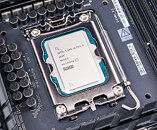- Joined
- Aug 19, 2017
- Messages
- 2,561 (0.97/day)
Intel has significantly changed its latest 0x112 microcode update, removing users' ability to bypass the Digital Linear Voltage Regulator (DLVR) through standard BIOS settings on "Arrow Lake" processors. DLVR, a technology designed to provide precise voltage control for individual performance cores and efficiency core clusters, offers great benefits during gaming sessions and light workloads. According to overclocker der8auer's analysis, DLVR can effectively manage power consumption during gaming, with power losses of around 20 W at typical gaming loads. However, these losses can shoot up to approximately 88 W under full CPU utilization. Previously, users could disable DLVR through a BIOS setting called "Power Gate" mode, which is particularly useful for intensive workloads where power losses might impact performance. With the new microcode update, this option has been removed from standard BIOS settings. It is also worth pointing out that DLVR is in its second iteration inside Arrow Lake CPUs, after the initial debut in "Raptor Lake," which had DLVR fused off.
Intel explained to Hardwareluxx that this change was implemented to "prevent accidental misuse of DLVR bypass," restricting its use to extreme overclocking scenarios involving sub-ambient cooling methods like liquid nitrogen. The update has already been rolled out through BIOS updates on some Z890 chipset motherboards, with ASRock and MSI being among the first manufacturers to implement the new microcode. While DLVR bypass may still be accessible through specialized LN2 profiles on high-end motherboards, the average enthusiast user loses direct control over this feature. This development mainly affects early Arrow Lake adopters, as not all motherboards include extreme overclocking profiles. While Intel's move appears to prevent potential issues, we must remember that power settings are something that users should only change with plenty of consideration. Removing this power gate mod is Intel prevention for Raptor Lake-like situations where these chips had an issue with Vmin shift.

View at TechPowerUp Main Site | Source
Intel explained to Hardwareluxx that this change was implemented to "prevent accidental misuse of DLVR bypass," restricting its use to extreme overclocking scenarios involving sub-ambient cooling methods like liquid nitrogen. The update has already been rolled out through BIOS updates on some Z890 chipset motherboards, with ASRock and MSI being among the first manufacturers to implement the new microcode. While DLVR bypass may still be accessible through specialized LN2 profiles on high-end motherboards, the average enthusiast user loses direct control over this feature. This development mainly affects early Arrow Lake adopters, as not all motherboards include extreme overclocking profiles. While Intel's move appears to prevent potential issues, we must remember that power settings are something that users should only change with plenty of consideration. Removing this power gate mod is Intel prevention for Raptor Lake-like situations where these chips had an issue with Vmin shift.

View at TechPowerUp Main Site | Source




